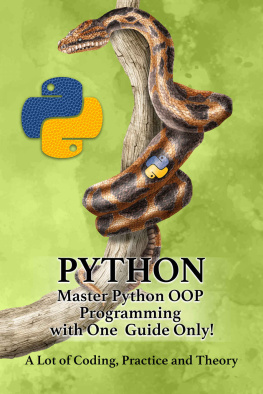Rick Sekuloski - PYTHON – Master Python OOP Programming with One Guide Only! A lot of Coding, Practice and Theory Learn Python with Hands-On Projects
Here you can read online Rick Sekuloski - PYTHON – Master Python OOP Programming with One Guide Only! A lot of Coding, Practice and Theory Learn Python with Hands-On Projects full text of the book (entire story) in english for free. Download pdf and epub, get meaning, cover and reviews about this ebook. year: 2022, genre: Computer. Description of the work, (preface) as well as reviews are available. Best literature library LitArk.com created for fans of good reading and offers a wide selection of genres:
Romance novel
Science fiction
Adventure
Detective
Science
History
Home and family
Prose
Art
Politics
Computer
Non-fiction
Religion
Business
Children
Humor
Choose a favorite category and find really read worthwhile books. Enjoy immersion in the world of imagination, feel the emotions of the characters or learn something new for yourself, make an fascinating discovery.
- Book:PYTHON – Master Python OOP Programming with One Guide Only! A lot of Coding, Practice and Theory Learn Python with Hands-On Projects
- Author:
- Genre:
- Year:2022
- Rating:4 / 5
- Favourites:Add to favourites
- Your mark:
PYTHON – Master Python OOP Programming with One Guide Only! A lot of Coding, Practice and Theory Learn Python with Hands-On Projects: summary, description and annotation
We offer to read an annotation, description, summary or preface (depends on what the author of the book "PYTHON – Master Python OOP Programming with One Guide Only! A lot of Coding, Practice and Theory Learn Python with Hands-On Projects" wrote himself). If you haven't found the necessary information about the book — write in the comments, we will try to find it.
Many people are afraid of programming because they think learning how to code is too hard.I was one of them! But if you want to learn and master Python programming, this is the book for you.
I have seen people buying many books and courses to learn Python but they never actually learned how to code. I promise my book will save you money and time. This book is balanced with theory and examples because I think the real-life examples are what you can really learn from.
Why buying my book?
Are you a beginner?
If you are a beginner then this book is perfect for you because I will use simple English to explain the hardest concepts. This book will guide you from the start and it will make you a professional Python developer at the end.
Full of theory and practical examples
This book is full of theory, examples, and screenshots so you can see how the code is executed and what output it produces. I will provide enough screenshots so that even if you dont run the code on the computer, you will still learn all of the Python features.
Every tool you need will be free
Every chapter of this book is selected and tailored according to what modern Python developers should know. The tools I will use are free so you can download them and use them for free. I promise you wont need to spend extra money.
Learn Python Programming Language very fast
This book is created so you can read, write, and execute code very fast. You can learn how to code Python in just a few days or weeks.
Few of the things you will learn in this book:
- What is Python?
- What are variables?
- What are comments?
- What are Python Data types?
- How to install Python
- How to execute Python
- What is OOP (Object Oriented Programming)?
- What are Integers?
- What are Floats?
- What are Strings?
- What are Tuples?
- What are Dictionaries?
- What are Sets?
- What are Lists?
- What are Objects?
- What are Functions?
- What are Statements?
- What are Operators?
- What are Augmented Operators?
- How to Install PyCharm IDE
- How to Install VS Code editor
- How to format Strings
- How to write your own functions
- What are errors?
- How to handle errors
- What are Classes?
- What are Instances?
- What are Constructors?
- The difference between functions and methods
- How to use replit.com to write and execute code
- How to create your own modules
- How to create packages
- How to import modules
- What is class Inheritance?
- Multiple Inheritance
- Python Indentation
- What are class attributes and methods?
- .
Hands-on projects:
Finally, youll be given two hands-on projects that require you to use the knowledge you have gathered them.
Click on the buy button. I cant wait to finally meet you.
Rick Sekuloski: author's other books
Who wrote PYTHON – Master Python OOP Programming with One Guide Only! A lot of Coding, Practice and Theory Learn Python with Hands-On Projects? Find out the surname, the name of the author of the book and a list of all author's works by series.











